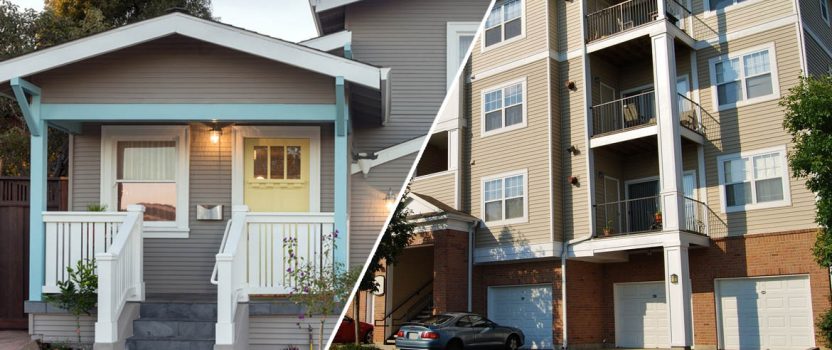Single-Family Vs Multi-Family Investments
Whether you’re new to real estate investing, or have several deals under your belt, you may be wondering which type of investment is right for you; single-family or multi-family. The answer to that depends a lot on your investment goals and strategy. We’re going to cover the different aspects of each below to help you decide on which types of investments you want to make.
Cost
Single-family rental investments are such an attractive property type because of their low cost to purchase compared to multi-family properties. The lower cost of single-family properties makes it easier for investors to get started, and to continue to purchase new properties. However, with single-family investments, the cost per unit is typically higher than with multi-family.
Depending on their size, multi-family properties can get quite expensive. The higher cost of multi-family properties compared to single-family makes it difficult for many investors to invest in multi-family deals. The cost per unit, however, is typically much lower. In many cases, the lower cost per unit provides the investor with a higher return on their investment.
While larger multi-family properties are too expensive for most investors to purchase, smaller multi-family properties (2-4 units) often provide a great opportunity for investors to move from single-family to multi-family deals. In many cases, a two or three-unit property doesn’t cost much more than a single-family.
Management
With real estate investing, there’s much more to success than just making the right purchase. Property management plays a huge role in the success of an investment.
On a per-unit basis, multi-family properties are typically easier to manage. Multiple tenants share the same roof and many mechanical items. If you have an eight-unit property, you only have to replace one roof, mow one lawn, and visit one property. With eight single-family properties, you have eight roofs to replace, eight lawns to mow, and eight properties to visit.
If you hire a professional property manager, you’ll usually find that the fee is slightly lower for multi-family properties than with single-family. Mainly for the same reasons mentioned above.
While multi-family properties might be simpler to manage, many investors find that they have better tenants in their single-family rentals. These tenants tend to be longer term, handle many of the small maintenance issues that come up and take overall better care of the property.
Financing
Almost every bank offers loans for single-family properties, and the process for obtaining those loans is pretty standard. With so many options available, it’s often easier to get financing.
Multi-family properties are considered commercial, requiring a different type of loan with a different underwriting process. Since it’s a commercial loan, there are fewer banks that offer loans for multi-family properties. While commercial loans can be difficult for new investors to obtain, once there is some history of success with rental properties banks are more likely to finance a multi-family deal.
Value
One of the key difference between single-family and multi-family properties is how they are valued. No matter what the income is on a single-family home, it is almost always valued based on comparable sales of other single-family homes in the area instead of being based on it’s income.
The value of multi-family properties is almost entirely based on the income it generates. The market will determine an expected rate of return on multi-family properties, and that rate of return will determine the property’s value.
One common method of determining the value of a multi-family property is a capitalization rate, or “cap rate” for short. Simple put, a cap rate is the percentage of the property’s purchase price received in net income annually, before the loan payments. For example, if a property cost $1,000,000 and it generated a net profit of $100,000 per year, the cap rate would be 10% since $100,000 is 10% of $1,000,000.
Using that same property generating a net profit of $100,000, if the expected cap rate in a particular market is 8% the value would be $1,250,000. $100,000 / 8% = $1,250,000
Net Operating Income (NOI) / Cap Rate = Property Value.
Of course, there are many other factors to consider when deciding whether to purchase a single-family home or a multi-family property, but these main points should give you a better understanding of the difference between the property types, and which one better suits your current investment strategy and your investment goals.








